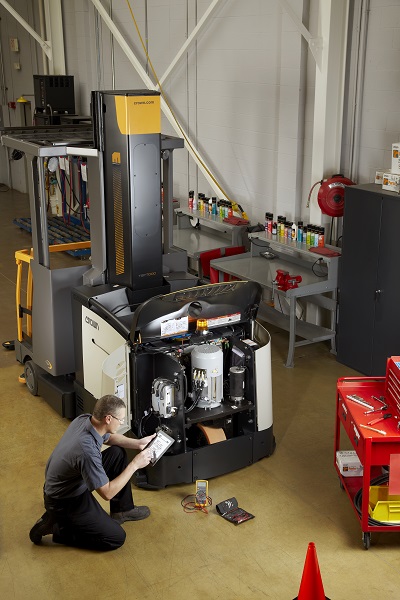Other Voices: Five steps to ensure a healthier forklift fleet
With or without telematics, disciplined assessments of a forklift fleet and its batteries can improve facility operations as well as the broader supply chain.

Editor’s note: The following column by Craig Bruns, vice president of customer support, Crown Equipment, is part of Modern’s Other Voices column, a series featuring ideas, opinions and insights from end-users, analysts, systems integrators and OEMs. Click here to learn about submitting a column for consideration.
—————-
If you manage a fleet of forklifts, there’s no better time to think about the health of your fleet. When it comes to the performance of your supply chain, the health of your forklifts is vital. An unhealthy fleet can lead to lower productivity, considerable inefficiencies, higher service and maintenance costs, and unsafe working conditions.
The following are five steps you can take to help ensure you have a healthy forklift fleet to continue to meet customer expectations and demands.
1. Conduct an annual equipment health assessment
If performing an assessment for the first time, it is important to establish a baseline for future years. Create and maintain an accurate listing of your fleet. Take a photo of every single truck and document the age, serial number, hours of battery life, number of charges and the year added. Moving forward, this will give you the ability to maintain an accurate profile of your fleet, including size, age and cost. By updating the listing every year, you can better understand how your fleet changes and plan where you need to be in the future. You can also use this time to have a trained technician conduct annual, planned maintenance and lubricate moving parts, such as mast stages.
2. Do the same with your batteries
Next, create a similar listing for your batteries. Forklift batteries are one of the most vital aspects of managing a fleet. When not managed properly, batteries can negatively impact the performance and operational productivity of the fleet. Annually document the condition and capacity level of each battery and conduct battery tests. Using monitoring technology, you can identify remaining cycles and life left for each battery. This type of information will help you create battery performance profiles that track performance throughout a given time period or for a particular application to ensure optimal performance.
3. Track and analyze your maintenance history
Bring clarity to your service and maintenance program by tracking the maintenance history for each truck. Document every maintenance issue with the battery and truck for the entire year, including the cost of each repair or service. Also, list all the planned maintenance work orders and breakdowns in the year and determine the planned maintenance to breakdown ratio. You can get the average cost per model from your forklift provider and use it to benchmark your fleet. Use this type of information to help you identify trends, be more proactive about repairs, and properly and efficiently address issues. At the same time, you can enhance your service and maintenance program, shortening mean time to repair (MTTR) and reducing downtime.
4. Monitor utilization rates of your forklifts
Make an effort to understand how and when your forklifts are being used. At any given time, you should know how many forklifts are in operation or sitting idle, which can be extremely valuable in right-sizing your fleet. Armed with this information, you can make real decisions about the number and types of forklifts you have and better manage your resources. You can determine if you need to rent or buy additional trucks or simply reallocate certain ones within your organization. You can also paint an accurate picture of how many forklifts you need at each facility during peak seasons.
5. Begin exploring telematics
There is a wealth of data that can be gathered from forklifts. Identify and prioritize the type of data you want to gather and establish a plan and processes to share relevant, timely information with the right departments and individuals at the right time. Make sure the data is presented in a manner that makes it easy to understand and use it to effect real, meaningful operational and behavioral changes. Initially, focus on a few key operational objectives. As you make progress and see real ROI, you can expand your efforts and tackle larger business objectives.
By undertaking the incremental steps outlined in this article, you will not only put in place a new health regimen for your fleet, but also realize significant, tangible benefits with the performance of your supply chain.

Article Topics
Blogs News & Resources
Learn from lift truck service history Two voices of reason on pallet materials 60 Seconds with Bob Trebilcock, outgoing executive editor, Modern Materials Handling The reBound Podcast: How Pitney-Bowes is innovating with autonomous vehicles. Packaging Corner: Be open to change 60 Seconds with Robert Martichenko of American Logistics Aid Network The reBound Podcast: Looking for talent in all the right places: How Essendant is revolutionizing recruitment More BlogsLatest in Materials Handling
Geek+ and System Teknik deploy PopPick solution for pharmacy group Med24.dk Beckhoff USA opens new office in Austin, Texas Manhattan Associates selects TeamViewer as partner for warehouse vision picking ASME Foundation wins grant for technical workforce development The (Not So) Secret Weapons: How Key Cabinets and Asset Management Lockers Are Changing Supply Chain Operations MODEX C-Suite Interview with Harold Vanasse: The perfect blend of automation and sustainability Consultant and industry leader John M. Hill passes on at age 86 More Materials HandlingSubscribe to Materials Handling Magazine

Find out what the world's most innovative companies are doing to improve productivity in their plants and distribution centers.
Start your FREE subscription today.
April 2024 Modern Materials Handling

Latest Resources










